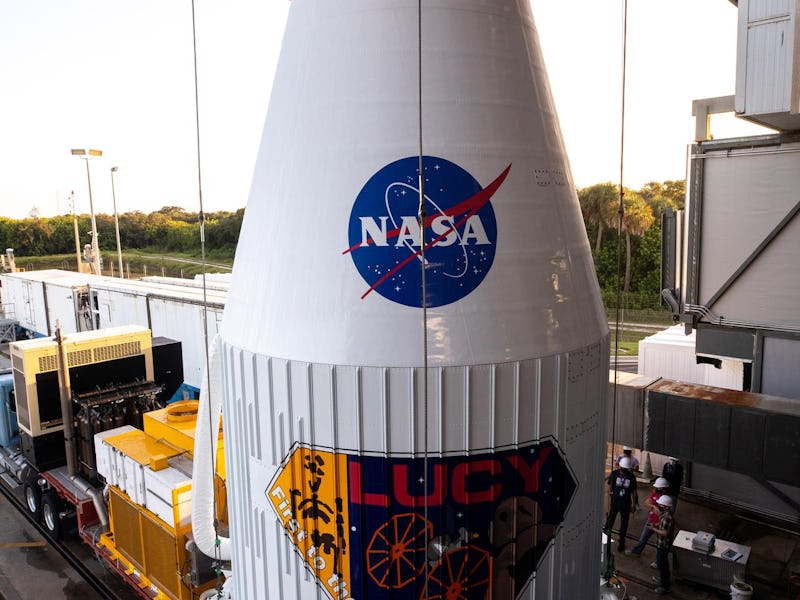Lucy: How to watch NASA's audacious Trojan asteroid mission
On October 16 the Lucy spacecraft will embark on its 12-year mission.

No word on any diamonds, but there will be a Lucy in the sky this weekend.
On Saturday NASA’s Lucy spacecraft will launch from Space Launch Complex 41 at Cape Canaveral, Florida. It’s the beginning of a 12-year mission that will see the probe visit ancient asteroids and fly between Jupiter and Earth multiple times.
The Lucy mission will not only test out new and unusual flight paths for a NASA planetary science mission, but it may also provide new clues to how the infant Solar System formed — and ultimately led to life on Earth. Lucy will soar by seven Trojan asteroids and one main belt asteroid.
In essence, it is a journey toward primordial space — and a voyage no spacecraft has attempted before. You can feel a part of it by watching its launch on Saturday.
When to watch the Lucy mission launch
Lucy is scheduled to launch as early as 5:34 a.m. Eastern on Saturday, October 16.
An illustration of the Lucy spacecraft.
Saturday is technically the start of its 23-day launch window. Every morning during this period there will be a 1-hour opportunity for launch.
How to watch the Lucy mission launch
Live coverage of the Lucy launch will begin at 5 a.m. Eastern on NASA TV and the space agency’s website at https://www.nasa.gov/live/.
If you live in Florida near the launch video, you can also post up at one of the launch viewing areas around Cape Canaveral.
What are the Trojan asteroids?
The Trojan asteroids are two populations of thousands of space rocks that share an orbit with Jupiter, one group leading the gas giant around the L4 Long-range point and the other trailing Jupiter around the L5 Lagrangian point.
Lagrangian points are coordinates in space where the gravitational pull of the Sun and a planet, in this case, Jupiter, balance out so that objects orbiting at those points maintain the same position relative to Jupiter as they all swing around the sun.
An artists rendering of the Trojan Asteroids near Jupiter.
First discovered in 1906, the astronomers have now identified more than 4,800 Jupiter Trojan asteroids.
The term “Trojan” stems from the initial decision to name the L4 asteroids after the Greek soldiers in The Illiad and L5 asteroids after the Trojan warriors in the epic poem about the ancient Trojan War. Trojan came to refer to any asteroid that shares an orbit with a planet, for instance, the Neptunian Trojans discovered in 2006.
However, recently the International Astronomical Union realized there were more Trojan asteroids than names in The Illiad. This spurred the decision to name smaller Trojan asteroids after Olympic and Paralympic athletes. The Trojan asteroid Queta — discovered in 2020 and named for Mexican track and field athlete Norma Enriqueta “Queta” Basilio Sotelo — was the first to be named under this convention.
Why is the purpose of the Lucy mission?
The Jupiter Trojans are believed to date to the very earliest days of the Solar System, fossilized remnants from more than 4 billion years ago. Lucy draws its name from Lucy, the fossilized Australopithecus afarensis — and human ancestor — discovered in 1974 (Lucy the skeleton was named after the Beatles song, “Lucy in the sky with diamonds”).
The first half of the United Launch Alliance (ULA) payload fairing is moved toward the Lucy spacecraft.
Lucy the spacecraft will be the first mission to visit these time capsules, visiting seven Trojans and one main asteroid belt asteroid on the way.
It will also fly in a unique orbit, making multiple gravity assist passes by Earth to visit both clusters of Jupiter Trojans, making Lucy the first spacecraft to ever fly that far from Earth and then return to the inner solar system.
Over the course of its 12-year mission, Lucy could help scientists better understand the origins of our Solar System and the process of planetary formation in other solar systems.
Who built the Lucy Spacecraft?
Lucy is lifted by a crane at the Astrotech Space Operations Facility in Titusville, Florida in August 2021.
Aerospace company and defense contract Lockheed-Martin designed and built Lucy for NASA.
What rocket will Lucy launch on?
Lucy will launch atop an Atlas 401 V rocket.
This United Launch Alliance vehicle can produce more than 860,000 pounds of thrust at liftoff and can use up to five solid rocks boosters in addition to a liquid-fueled core booster. The upper stage is powered by one or two centaur rocket engines with 4-or-5 meter payload fairings.
The 401 designation refers to which available launch configuration is in use. In the case of the Lucy launch, the Atlas V will use a 4-meter fairing to house Lucy, zero solid rocket boosters, and one centaur engine for its upper stage.